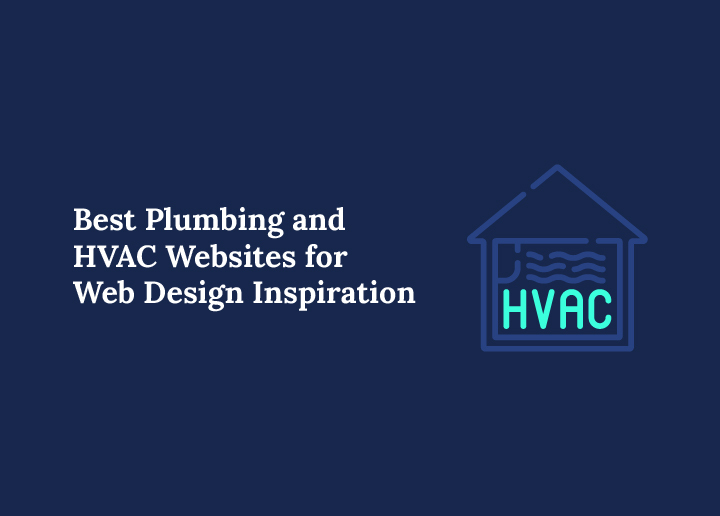Your website isn’t just an online brochure; it’s your virtual storefront, your lead generation engine, and a critical tool for building trust with potential customers. For plumbing and HVAC businesses, a well-designed website can distinguish between a thriving enterprise and one struggling to keep up. This comprehensive guide explores the best plumbing and HVAC websites for web design inspiration, diving deep into what makes them successful and how you can apply these principles to your own online strategy.
Every successful plumbing and HVAC website shares a common thread: an intuitive, visually appealing design coupled with powerful SEO strategies.
From the moment a potential customer lands on your site, they should be able to quickly find what they need, understand your services, and feel confident in your professionalism.
This article will help you uncover the secrets behind the best HVAC and plumbing websites, offering concrete examples and actionable advice to elevate your digital footprint.
How an Inspiring Plumbing and HVAC Website Designs Drive Customer Trust and Conversions?
A thoughtfully designed plumbing and HVAC website is more than just aesthetically pleasing; it’s a strategic asset that builds customer trust and drives conversions. In the competitive home services market, credibility is paramount.
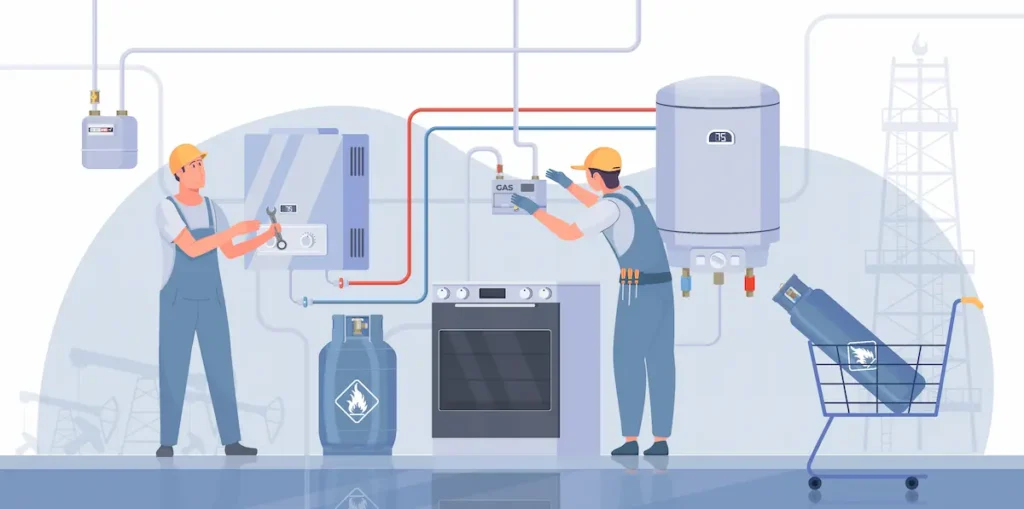
When homeowners face an urgent plumbing leak or a malfunctioning air conditioning unit, they must quickly identify a reliable, professional service provider. Your website’s design plays a crucial role in conveying that reliability.
Role of Customer Trust and Credibility in Home Services
Think about your own experiences. When you’re searching for a service, what makes you trust one company over another? Often, it’s the professional appearance, clear communication, and apparent expertise showcased on their website.
For plumbing and HVAC companies, establishing this trust online is vital. A website that looks outdated, is difficult to navigate, or lacks essential information can immediately erode a potential customer’s confidence.
Conversely, a modern, user-friendly, and informative site projects an image of competence and trustworthiness.
Building credibility also involves transparency. Clear pricing information (even if it’s a “request a quote” option), detailed service descriptions, and easily accessible contact details all contribute to a positive perception.
Customers want to feel assured that they are dealing with a legitimate and reputable HVAC company or plumbing business.
Also Learn: Top-Rated HVAC Website Design and Development Services
Elevate Your Plumbing or HVAC Brand Online
Launch a professional WordPress website with intuitive design, seamless functionality, and client-focused features.
Design Elements That Influence Conversions
Beyond trust, specific design elements directly influence conversion rates. You aim to guide website visitors seamlessly from browsing to taking action, whether scheduling service, requesting a quote, or calling your office.
- Prominent Calls to Action (CTAs): Clear, strategically placed “schedule service,” “request service,” “get a free estimate,” or “call now” buttons are essential. These should stand out visually and be easily clickable, especially on mobile devices.
- Testimonials and Reviews: Positive feedback from satisfied customers is powerful social proof. Displaying customer testimonials, Google reviews, and ratings prominently builds immediate trust. Many of the best plumbing and HVAC websites feature dedicated testimonial sections or review sliders.
- Service Area Clarity: Home services are inherently local. Clearly defining your service areas, perhaps with an interactive map or a dedicated service pages list, assures potential customers that you can serve them. This is also crucial for local SEO for HVAC companies and plumbing businesses.
- Easy Navigation: A user-friendly navigation bar, logically organized menus, and a clear site structure ensure that visitors can quickly find the information they need without frustration. This applies to essential pages like Services, About Us, Contact, and FAQs.
- High-Quality Visuals: Professional photos of your team, trucks, and actual work, along with high-quality images of equipment, create a polished impression. Avoid generic stock photos that don’t reflect your actual business.
Importance of Mobile-First and Responsive Layouts
In an era when most people access the internet via smartphones, a mobile-first and responsive design is not optional; it’s mandatory. A responsive HVAC website design ensures that your site automatically adjusts and looks great on any screen size, from desktops to tablets to mobile devices.
If potential customers struggle to navigate your site on their phone, they will likely leave and find a competitor with a better mobile experience. This also significantly impacts your search engine rankings, as Google prioritizes mobile-friendly websites.
Key takeaway: Investing in a great HVAC website design or plumbing website design is an investment in your business’s future. It enhances credibility, simplifies the customer journey, and directly contributes to lead generation and increased conversions.
Outstanding Plumbing and HVAC Websites That Set Design Standards
Let’s look at some exemplary plumbing and HVAC website examples to truly understand what makes a successful website. These examples showcase innovative design, effective SEO strategies, and a strong focus on user experience, serving as excellent plumbing and HVAC web design inspiration.
NRG Heating & Air Conditioning
NRG Heating & Air Conditioning features clear service menus, making it easy for website visitors to find specific services like AC repair or heating installation. Their site integrates employee videos, adding a personal touch that builds trust.
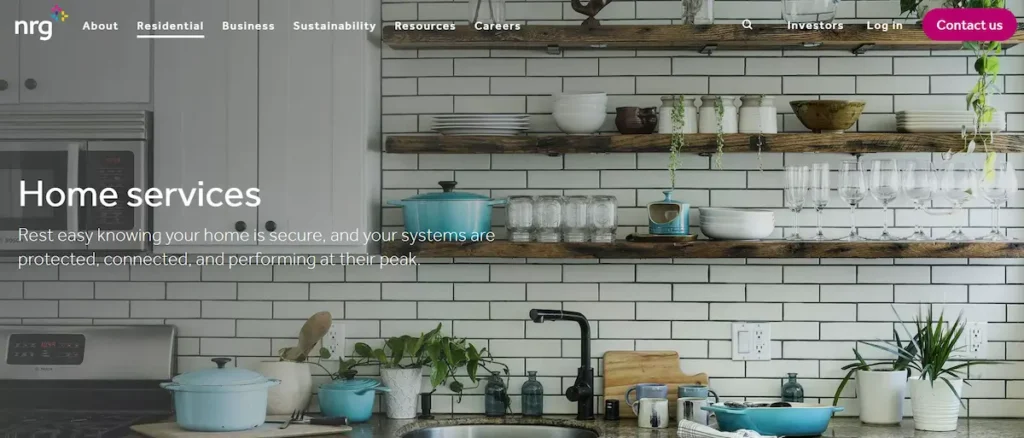
Furthermore, prominently displayed financing partner logos offer transparency and flexible payment options, appealing to a broader audience. This is a great example of a modern HVAC website.
Williams Mechanical
Williams Mechanical excels with a regularly updated blog that includes videos, providing valuable content for potential customers and boosting their HVAC website SEO.
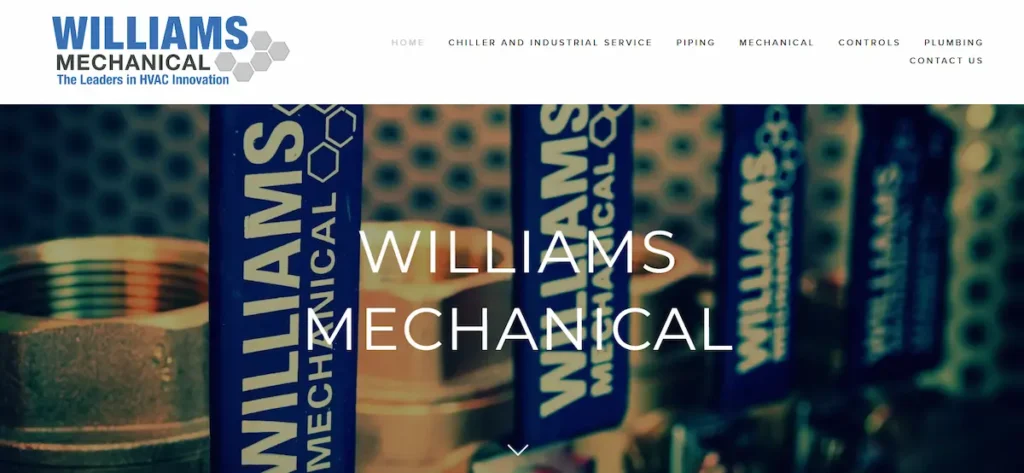
They feature dedicated FAQ and financing pages, addressing common customer questions and concerns upfront. An embedded service area map clearly defines their operational zones, critical for local businesses.
Quality Cooling & Heating
Quality Cooling & Heating‘s website boasts polished visuals and a sticky header that keeps contact information and key navigation elements always visible.
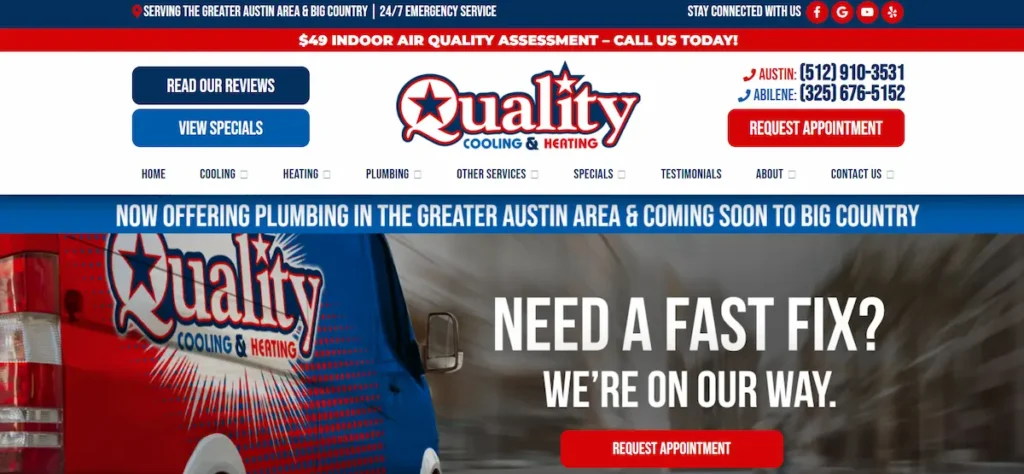
Strong, clear calls to action are strategically placed throughout the site, guiding visitors to request service or schedule an appointment. Their local SEO optimized pages target specific geographic areas, making them one of the top HVAC websites for local search.
Carini Home Services
Carini Home Services uses eco-friendly visuals, appealing to an environmentally conscious target audience.
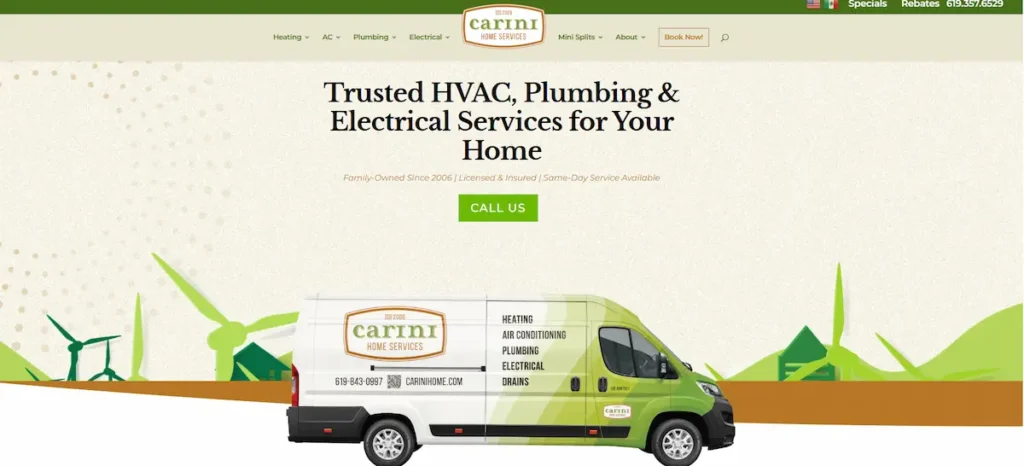
They offer multiple CTAs, including a live chat feature for immediate assistance, catering to different customer preferences. Their robust SEO metadata ensures they rank well for relevant searches, making them a strong HVAC company website example.
Altruistic AC & Heating
Altruistic AC & Heating impresses with a clean, modern look and a calming color palette. Their illustrative service headers visually break down complex services into easy-to-understand sections.
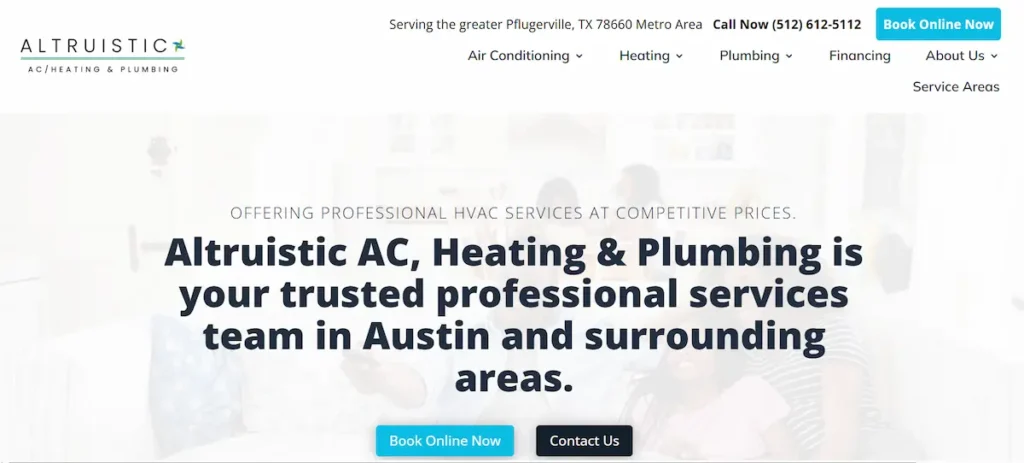
A review slider prominently displays positive customer feedback, building immediate trust and credibility.
Wheeler’s Plumbing, Heating, and Cooling
Wheeler’s Plumbing, Heating, and Cooling ensures contact hours and details are always visible, providing quick access for urgent needs.
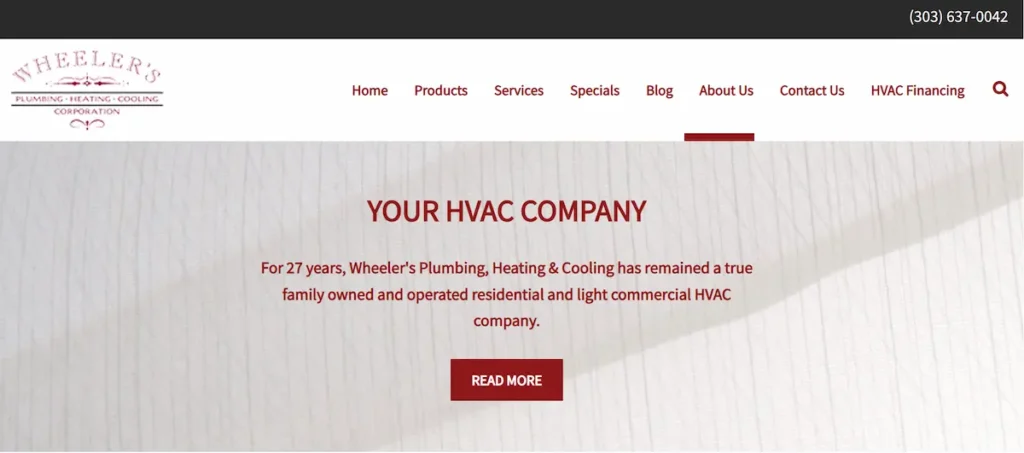
They feature a service cost calculator, offering transparent pricing estimations. Referral and seasonal specials, along with a dedicated testimonials section, incentivize new customers and build loyalty.
Smock HVAC
As featured in the Hook Agency portfolio, Smock HVAC showcases a standout professional design.
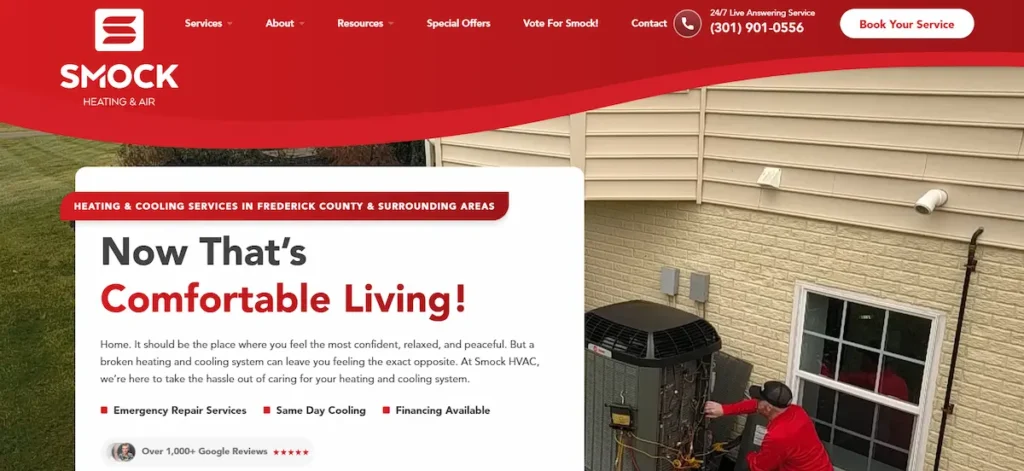
Their site is curated by a design company known for creating great HVAC website design, emphasizing a visually appealing and user-friendly experience that attracts more leads.
Guest Plumbing & Heating
Guest Plumbing & Heating, highlighted by Jobber, seamlessly integrates social media links, extending its online reach. A top-banner call-to-action ensures immediate visibility for its primary service offering.
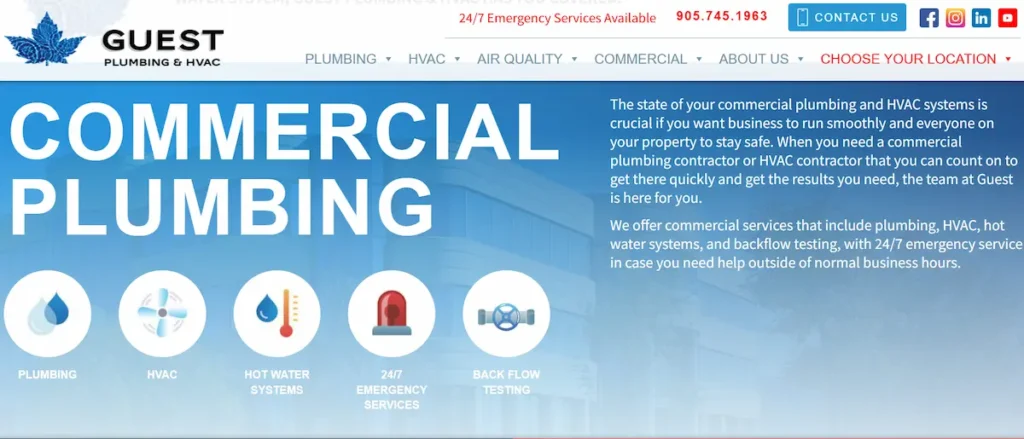
Easy contact access, including a request service button, streamlines the lead generation process. This is one of the best plumbing websites for user-friendliness.
These plumbing and HVAC website examples prove that investing in professional web design services can significantly impact a contractor’s success.
Key Design and SEO Elements That Make These Plumbing and HVAC Websites Shine
The success of these best plumbing and HVAC websites isn’t accidental. It’s the result of carefully integrating design best practices with robust HVAC website SEO strategies.
Understanding these elements is crucial for anyone looking to build or revamp their own plumbing and HVAC website.
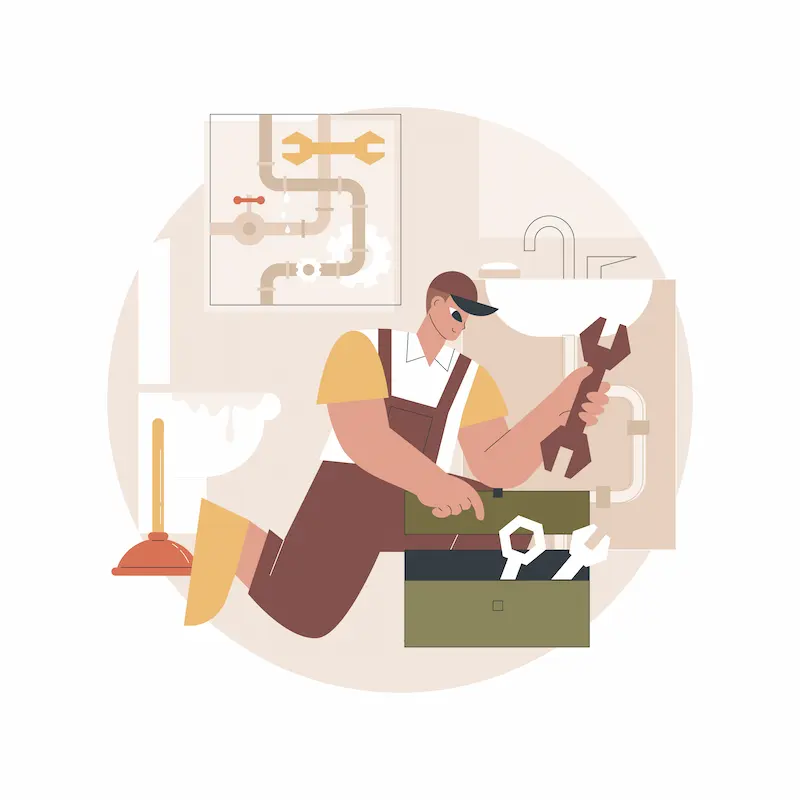
Unified Visual Theme and Branding Consistency
A strong brand identity is crucial. This means using consistent colors, fonts, and imagery across your entire website and marketing materials.
A unified visual theme makes your plumbing and HVAC business look professional and memorable. From your logo to your team photo, everything should align, creating a cohesive and trustworthy image for potential customers.
Mobile-Friendly, Responsive Performance and Quick Loading
As previously emphasized, a responsive design that adapts to mobile devices is non-negotiable. Beyond responsiveness, quick loading times are essential.
Users expect fast websites; slow-loading pages lead to high bounce rates and negatively impact your search engine ranking. Optimize images, minify code, and use efficient hosting to ensure your new HVAC website performs optimally. This is a core aspect of mobile-friendly HVAC websites.
Clear Navigation with Intuitive Menus and Easy Access to Services, About, Contact
A user-friendly navigation system is the backbone of any great website. Potential customers should be able to find what they’re looking for intuitively, whether it’s information about specific HVAC services, your company, or your contact details.
A clear navigation bar, often with a sticky header, ensures essential pages are always accessible, enhancing the customer journey.
Multiple, Visible CTAs (Book Now, Request Quote, Click-to-Call), Sticky Headers
Effective calls to action are vital for lead generation. Don’t make visitors search for how to schedule service or request a quote. Strategically place multiple CTAs throughout your site: in the hero section, features, navigation bar, service pages, and footer.
“Click-to-call” buttons are especially useful for mobile users seeking same-day service or emergency plumbing. A sticky header prominently displays these clear calls to action.
Trust Signals: Reviews, Testimonials, Certifications, BBB Logos
Building trust online is paramount for home services. Displaying customer testimonials, Google reviews, and positive feedback prominently instills confidence.
Include logos of relevant certifications, associations (like BBB), and any money-back guarantee or referral program you offer. These trust-building features assure potential customers of your high-quality service and professionalism.
Local SEO: Service-Area Pages, Embedded Maps, Addresses, Optimized Local Content
For plumbing and HVAC companies, local SEO is critical. Create dedicated service-area pages optimized with location-specific keywords. Embed an interactive map showing your coverage.
Clearly display your address, phone number, and hours. Craft local content that speaks directly to the needs of your community to attract more leads from your target audience.
Content Strategy: Blogs, FAQs, Tips, Educational Content for SEO and Trust
A robust content strategy not only boosts your HVAC website SEO but also establishes your company as an authority.
Regular blog posts on topics like energy efficiency, indoor air quality, or common plumbing issues attract website visitors and provide valuable information.
FAQ pages address common queries, reducing customer service calls. Educational content builds trust and can help convert potential customers into satisfied customers.
Technical Performance: Optimized Images, Minified Assets, Improved PageSpeed
Solid technical performance is behind every visually appealing and fast website. To improve page speed, optimize all images for the web, compress CSS and JavaScript files (minify assets), and leverage browser caching.
A technically sound website provides a smooth, user-friendly experience and is favored by search engines, leading to better search engine rankings.
By focusing on these key design and SEO elements, your plumbing and HVAC website can attract more customers, generate more leads, and ultimately grow your HVAC business.
How to Leverage AI and SEO to Build Your Own High-Performing Plumbing and HVAC Website
Building a high-performing plumbing and HVAC website in today’s digital landscape requires a smart approach that integrates cutting-edge tools like AI with proven SEO strategies. This combination can significantly enhance your online presence, attracting more leads and converting them into satisfied customers.
Use AI for Generating Localized Service Content, FAQs, Blog Ideas
Artificial intelligence tools can be a game-changer for content creation. AI can assist in generating:
- Localized service content: Provide AI with your service areas, and it can help draft unique, SEO-optimized descriptions for each location, discussing specific needs or common issues in San Diego, for example.
- FAQs: AI can analyze common customer queries related to air conditioning, heating, or water heater repair and generate comprehensive FAQ answers, making your user-friendly plumbing websites more informative.
- Blog ideas and drafts: Stuck for blog topics? AI can suggest relevant blog posts that address indoor air quality, energy efficiency, or tips for maintaining your HVAC system, all tailored to your HVAC website marketing goals. It can even help draft initial outlines or full articles, saving you time and resources. This helps create valuable content that attracts website visitors.
Incorporate Primary and LSI Keywords Naturally Within Headings and Body Copy
SEO is all about relevance. Ensure your primary keywords, such as “Plumbing and HVAC Websites,” “Best HVAC Websites,” and “Plumbing and HVAC Website Design,” appear naturally throughout your site.
Beyond primary keywords, integrate LSI (Latent Semantic Indexing) keywords like “heating and cooling website design,” “air conditioning service website examples,” and “home services website design.”
This signals to search engines that your content is comprehensive and relevant, improving your search engine rankings.
Optimize Meta Titles, Descriptions, Alt Tags, and H-tags for On-Page SEO
On-page SEO fundamentals remain critical. Each page needs:
- Meta Titles and Descriptions: Craft compelling, keyword-rich meta titles and descriptions that entice users to click from search results.
- Alt Tags: Add descriptive alt tags to all your high-quality images, not only for accessibility but also to provide more context to search engines.
- H-tags (H1, H2, H3): Use proper heading hierarchy. Your H1 should contain your main keyword, and H2s and H3s should break down content into readable sections, naturally incorporating secondary and tertiary keywords.
Structure Content: H1, H2s, H3s with Integrated Keywords, Bullet Lists, Internal Linking
Well-structured content is easier for both users and search engines to digest.
- Hierarchy: Use one H1 per page, followed by logical H2s and H3s to organize your content.
- Keywords: Integrate keywords naturally within these headings and the body copy.
- Readability: Break up long paragraphs with bullet lists, numbered lists, and shorter sentences for improved readability.
- Internal Linking: Link to other relevant pages on your site (e.g., from a blog post about AC repair to your AC services page). This improves user navigation and distributes “link juice” across your site, boosting SEO.
Use AI Tools to Suggest CTAs and A/B Test Variations
AI can analyze user behavior and suggest optimal calls to action (CTAs) for your website. It can help you identify where to place a “request service button,” what wording resonates best, and even design visually appealing buttons.
Furthermore, AI-powered tools can facilitate A/B testing of different CTA variations (e.g., “Schedule Service” vs. “Book Appointment”) to determine which ones generate the most leads and conversions. This data-driven approach ensures your clear calls to action are as effective as possible.
Track Performance Via Google Analytics and Optimize Using Data Insights
The work doesn’t stop once your new website is live. Continuously track its performance using tools like Google Analytics. Monitor key metrics such as:
- Traffic sources: Where are your website visitors coming from?
- Bounce rate: How many users leave your site after viewing only one page?
- Time on page: How long do users spend on different pages?
- Conversion rates: How many visitors complete a desired action (e.g., fill out a contact form, schedule service)?
Use these data insights to identify areas for improvement. Perhaps a particular service page has a high bounce rate, suggesting the content isn’t engaging or the CTA isn’t clear.
By continually optimizing based on real data, you can ensure your plumbing and HVAC website remains a high-performing asset for your business, attracting more leads and customers.
By combining the power of AI with a solid SEO strategy and a focus on user experience, you can create one of the best plumbing and HVAC websites that stand out in a crowded market and drive sustainable growth for your business.
Conclusion
A strong online presence begins with a well-designed website, and the best plumbing and HVAC websites prove that design, usability, and SEO must work together.
These examples highlight what truly engages customers, from mobile-friendly layouts to clear calls to action and authentic client testimonials.
Whether you run an HVAC company, plumbing service, or air conditioning business, investing in professional web design and integrating tools like Google reviews, optimized contact forms, and separate service pages will set your company apart. Draw inspiration from other websites and take the next step toward building a site that drives growth.
FAQs About Best Plumbing and HVAC Websites
What makes the best HVAC websites stand out in the industry?
The best HVAC websites feature mobile-friendly design, strong visual branding, clear calls to action, and localized SEO elements such as service area maps and Google reviews. These features build trust and encourage potential customers to schedule services.
Why are online reviews and client testimonials crucial for an HVAC business website?
Online reviews and client testimonials act as social proof. Featuring Google reviews and customer stories prominently on HVAC company websites increases credibility and can influence a visitor’s decision to choose your services.
Should HVAC companies create separate pages for services?
Yes. Separate pages for heating, air conditioning, or water heater repair services improve SEO and provide clarity. This structure helps search engines understand your offerings and makes it easier for users to find relevant information.
Can website builders deliver professional HVAC website design?
Modern website builders and WordPress themes allow HVAC companies to create mobile-friendly, visually appealing designs with built-in contact forms. However, hiring experienced design companies often ensures higher customization and SEO optimization.
How can HVAC companies use Google Ads with their websites?
Google Ads can drive targeted traffic to HVAC websites. Pairing ads with optimized landing pages, strong calls to action, and easy-to-use contact forms increases conversion rates and maximizes ad spend efficiency.
